Eclectic - Bent Arm in Oval
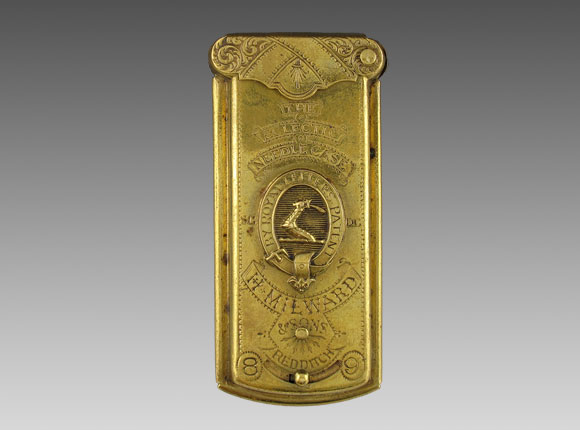
Needle Case

UK Patent 1868-3517 drawing
Design Details
Needle Case Type: |
Quadruple |
Patent/Registered to: |
William Avery, Redditch Needle Manufacturer and Albert Fenton of the same place, Machinist |
Patent/Design Representation #: |
Mechanical Patent: #3517 |
Patent/Design Registration Date: |
November 19, 1868 |
Location of Patent/Design Registration: |
British Library - Business and Intellectual Property Centre – London |
Reference #: |
1868-3517, Figures 7-10 |
Dimensions: |
3.3 x 7 |
Material: |
Brass |
Name Variations: |
a) H. Milward & Sons - Redditch with regular endcap
b) H. Milward & Sons - Redditch with special "Use Clark's Spool Cotton" endcap
c) J. & G. Morton - 39 Cheapside, London (signed per Horowitz and Mann) |
Other Variations: |
Nickel-silver version
See other Quadruples |
US Patent |
US 1870-98904 |
Additional Photographs
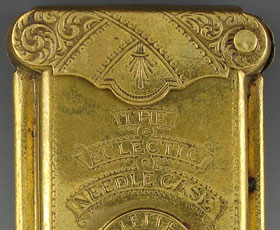


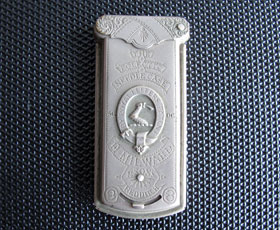
Detail views and nickel-silver version (photo of nickel-silver version courtesy of Bunny's Place)
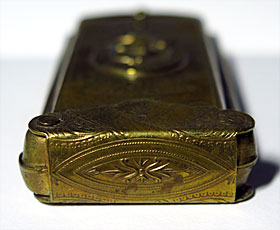
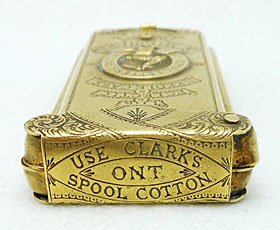
Detail views with a regular endcap (left) and with the "Use Clark's Spool Cotton" endncap (right photograph from eBay)
Facts
A shield with a bent arm and sword is occasionally found on a family crest or coat of arms. According to several heraldry websites an arm
in armor bent at the elbow signifies a person with qualities of leadership whereas the sword symbolizes power, protection, authority, strength,
honor and courage. The company whose name appears on this needle case, H. Milward & Sons, may have selected the bent arm with sword to
represent their company because they intended to be a strong company and were in fact one of the leaders in the production of needles during the
18th and 19th centuries.
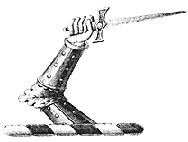
History
A coat of arms is a shield with symbols and figures that represent a person, family, group or other organization. Although the ancient
Romans had shields with special insignia on them, it wasn’t until the Medieval Period that coats of arms became common. In the 12th century
they were used basically by feudal lords and knights as a way of identifying groups on the battlefield. However by the 13th century their use
spread to the European aristocracy where the family crest was inherited from one generation to the next. Within a few centuries the use of
coats of arms extended to civic organizations such as towns, cities, regions, universities, religious groups and the like. The Royal Coat of
Arms of the United Kingdom is pictured below.

Miscellaneous
Instituting the use of surnames was another way to identify individuals or related groups. Before record keeping began, most people had
only one name such as John, however as the population increased it became necessary to distinguish between individuals with the same name. The
problem was solved by adding descriptive information based on one of the following characteristic: patronymic (named after a parent), occupational
(based on the person occupation), geographic (based on the place where the person was from) or a nickname based on a physical attribute. As a
result John became John Hunter, John Erickson, John Glasgow or John Cameron (means hook nose in Gaelic).
Milward, a variation of Millward, is an English surname that originating in Southern England and the West Midlands, the area in west central
England in and round the city of Birmingham. It is based on the pre 7th century Old English words “mylen” meaning mill and “weard” the keeper
of or guardian of. Therefore Milward is an occupational name for someone in charge of a mill. This is fitting since H. Milward &
Sons, one of the largest needle manufacturing companies in the world during the Victorian Period, operated a needle factory at the Washford Mill in
Redditch during the 18th and early 19th centuries.
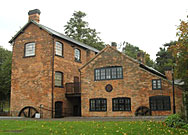
Forge Mill Needle Museum















